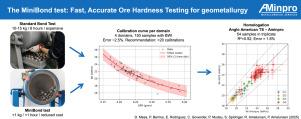MiniBond测试:一种可靠且具有成本效益的矿石硬度表征和地质冶金分析替代方案
IF 5
2区 工程技术
Q1 ENGINEERING, CHEMICAL
引用次数: 0
摘要
有效的矿石硬度表征是有效的地质冶金建模和矿山规划的关键。然而,传统的Bond Work Index (BWi)测试尽管具有既定的准确性,但在成本、时间和样品要求方面是资源密集型的。本文介绍了MiniBond测试,这是一种新型的小尺寸研磨性测试,旨在使用更小的样本量(约600克)提供可靠的BWi估计。在不同的矿物学领域(超过80个矿石样品)进行了广泛的校准,验证了与传统Bond测试的高相关性(R2=0.98),内部校准误差始终低于3%。ampro和英美资源集团合作进行的双盲认证和验证研究证实了该测试在实验室中的可重复性,误差小于5%。通过显著降低每次测试的成本(约80%)并实现高通量测试,MiniBond测试增强了地质冶金数据集的密度,提高了地质统计插值的可靠性。本文详细介绍了MiniBond测试程序、广泛的校准和认证活动,并讨论了在大规模资源评估中实施该方法的实际意义和优势。本文章由计算机程序翻译,如有差异,请以英文原文为准。

The MiniBond test: A robust and cost-effective alternative for ore hardness characterisation and geometallurgical profiling
Efficient ore hardness characterisation is pivotal for effective geometallurgical modelling and mine planning. However, conventional Bond Work Index (BWi) tests, despite their established accuracy, are resource-intensive in terms of cost, time, and sample requirements. This article introduces the MiniBond test, a novel reduced-scale grindability assay designed to provide reliable BWi estimates using significantly lower sample volumes (approximately 600 grams). Extensive calibration across diverse mineralogical domains (over 80 ore samples) validated a high correlation (R) with the traditional Bond test and internal calibration errors consistently below 3%. Double-blind homologation and validation studies conducted collaboratively between Aminpro and Anglo American confirmed the test’s operational reproducibility across laboratories, achieving less than 5% variation. By significantly reducing the cost per test (approximately 80%) and enabling high-throughput testing, the MiniBond test enhances the density of geometallurgical datasets, improving geostatistical interpolation reliability. This paper presents a detailed description of the MiniBond test procedure, the extensive calibration and homologation campaigns, and discusses the practical implications and advantages of implementing this method for large-scale resource evaluation.
求助全文
通过发布文献求助,成功后即可免费获取论文全文。
去求助
来源期刊

Minerals Engineering
工程技术-工程:化工
CiteScore
8.70
自引率
18.80%
发文量
519
审稿时长
81 days
期刊介绍:
The purpose of the journal is to provide for the rapid publication of topical papers featuring the latest developments in the allied fields of mineral processing and extractive metallurgy. Its wide ranging coverage of research and practical (operating) topics includes physical separation methods, such as comminution, flotation concentration and dewatering, chemical methods such as bio-, hydro-, and electro-metallurgy, analytical techniques, process control, simulation and instrumentation, and mineralogical aspects of processing. Environmental issues, particularly those pertaining to sustainable development, will also be strongly covered.
 求助内容:
求助内容: 应助结果提醒方式:
应助结果提醒方式:


